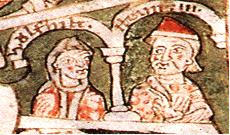Henry IX, Duke of Bavaria facts for kids
Quick facts for kids
Henry IX
|
|
|---|---|
| Duke of Bavaria | |

Henry IX and his wife Wulfhilde, Historia Welforum (12th century)
|
|
| Born | 1075 |
| Died | 13 December 1126 (aged 50–51) Ravensburg, Swabia |
| Buried | Weingarten Abbey |
| Noble family | House of Welf |
| Spouse(s) | Wulfhilde of Saxony |
| Issue | Judith Conrad Henry X the Proud Welf VI Sophia |
| Father | Welf I, Duke of Bavaria |
| Mother | Judith of Flanders |
Henry IX (born 1075, died December 13, 1126) was a powerful noble known as the Black. He belonged to the House of Welf, a very important family in Europe. Henry was the Duke of Bavaria from 1120 until 1126.
Contents
Early Life and Family
Henry was the second son of Duke Welf I of Bavaria and his wife Judith. When he was young, Henry managed his family's lands in Italy, south of the Alps.
Around 1095, Henry married Wulfhilde of Saxony. She was the daughter of Duke Magnus of Saxony. Through this marriage, Henry gained control of some important lands around Lüneburg. These lands later became the center of the Welf family's power.
When Duke Magnus died in 1106 without any sons, Henry hoped to become the new Duke of Saxony. However, the new king, Henry V, chose someone else: Count Lothair of Supplinburg.
A Powerful Duke
Even though Henry didn't become Duke of Saxony, he stayed on good terms with the ruling family, the Salian dynasty. In 1116, he joined Emperor Henry V's trip to Italy. They went to take over lands that belonged to a powerful woman named Matilda of Tuscany after she passed away.
In 1120, Henry's older brother, Welf II, died without children. So, Henry became the new Duke of Bavaria. He also played a big part in ending a long-standing argument between the Pope and the Emperor. This argument was called the Investiture Controversy, and it was settled by an agreement known as the Concordat of Worms in 1122.
Family History and Royal Choices
In the early 1120s, Duke Henry asked for a book to be written about his family's history. It was called the Genealogia Welforum and was written in Latin at Weingarten Abbey. He might have been inspired by the church making Bishop Conrad of Constance a saint in 1123. Conrad was also a Welf, and this made Henry more interested in his family's past.
Henry also had a very important role in choosing the new king in 1125. At first, he supported his son-in-law, Frederick II, Duke of Swabia. But then, Henry changed his mind and supported his old rival, Duke Lothair of Saxony. This was probably because Lothair promised that his only daughter, Gertrude, would marry Henry's son, Henry the Proud. This marriage happened in May 1127. This decision caused a big disagreement between the Welf family and the Hohenstaufen family, which lasted for many years. This conflict led to the famous "Guelphs and Ghibellines" rivalry.
After Lothair became king, he declared Frederick II an enemy. However, the king's army couldn't defeat Frederick's forces. In 1126, Henry decided to step down as Duke of Bavaria. He gave the title to his second son, Henry the Proud. Henry then went to live at Weingarten Abbey in Upper Swabia, a place his family had supported. He might have done this to avoid having to fight against his son-in-law, Frederick II.
Henry died soon after and was buried at Weingarten. His wife, Wulfhilde, passed away just 16 days later. Henry was called "the Black," but this nickname wasn't used until the 13th century. Two very famous people were his grandsons: Emperor Frederick Barbarossa and Henry the Lion.
Children
Henry and Wulfhilde had several children:
- Judith, who married Frederick II, Duke of Swabia.
- Conrad (died March 17, 1126).
- Henry X the Proud, who married Gertrude of Süpplingenburg. He became Duke of Bavaria after his father.
- Welf VI (died 1191).
- Sophia, who married Berthold III, Duke of Zähringen and later Margrave Leopold of Styria.
- Wulfhild, who married Rudolf I, Count of Bregenz.
- Mathilde, who married Diepold IV, Margrave of Vohburg and Count Gebhard III of Sulzbach.
- Adalbert, Abbot of Corvey.
Images for kids


